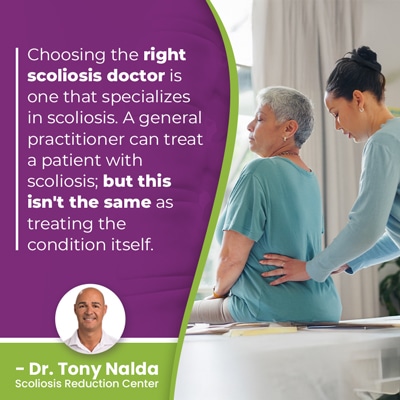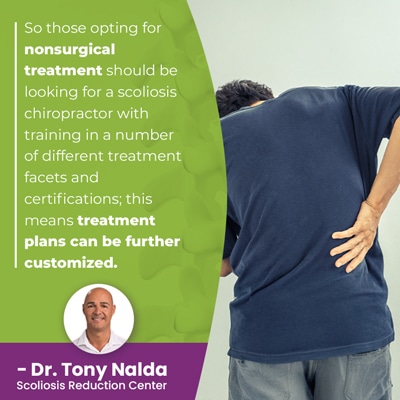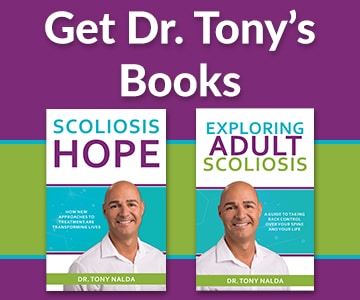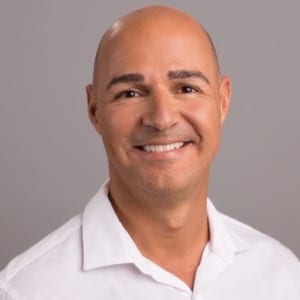How to Choose the Right Scoliosis Doctor: Expert Tips

There are different scoliosis treatment approaches, and patients need to fully understand the different potential results they offer to make informed treatment choices. The right doctor for treating scoliosis is one that doesn't just address symptoms of the condition, but specializes in correcting it.
When it comes to being diagnosed with scoliosis, the way a patient responds with treatment is key; this will shape the spine's long-term health. Choosing the right scoliosis doctor means one that specializes in scoliosis and has experience with the type of treatment approach a patient is interested in.
Before getting to some specific questions to ask a potential scoliosis doctor, let's talk generally about the two main scoliosis treatment approaches.
Table of Contents
Scoliosis
Current estimates have close to seven million people living with scoliosis in the United States alone, and as the leading spinal condition among school-aged children, it should be taken seriously and warrants awareness.
Scoliosis is a progressive spinal condition that causes the spine to bend and twist unnaturally, and this disrupts the biomechanics of the entire spine.
There are a number of spinal conditions that cause a loss of the spine's healthy curves, but the rotational component sets scoliosis apart from the rest and makes it particularly complex to treat.
A spine with its natural curves in place will take on an 'S' shape when viewed from the sides but will appear straight when viewed from the front or back; a spine's healthy curves make it stronger, more flexible, more balanced, stable, and able to absorb and distribute mechanical stress incurred during movement.
As a progressive condition, the nature of scoliosis is to get worse over time, meaning the size of rotation of the unnatural spinal curve is increasing, as are the condition's effects.
The spine will get increasingly rigid with progression, making it less responsive to treatment.
Smaller curves are simpler to correct, and with most progressive conditions, it's more effective to proactively work towards preventing increasing symptoms than attempting their reverse once established.
As progression is occurring, the condition is becoming more complex to treat; this increases the likelihood that more aggressive treatment will be necessary in the future.
Scoliosis Symptoms
When it comes to childhood scoliosis, the most noticeable symptoms of scoliosis are postural changes that include uneven shoulders and hips, the development of a rib cage arch, ill-fitting clothing, and changes to balance, coordination, and gait are also common.
In adults for whom the condition is compressive, pain is the main symptom of scoliosis that leads to assessment and diagnosis.
In young patients who are still growing, the spine's constant lengthening motion during growth counteracts the compressive force of the unnatural spinal curve.
Postural and movement changes are also common in adults, but compressive pain can involve the muscles, back, and pain that radiates into the extremities due to nerve compression.
Adults tend to progress slower because progression is triggered by growth and adults are no longer growing; however, in older adults experiencing natural age-related spinal degeneration, degenerative scoliosis can progress quickly.
Scoliosis Severity and Type of Scoliosis
Scoliosis ranges in severity from mild scoliosis to moderate scoliosis, severe and very severe cases, and there are also different types of scoliosis: idiopathic scoliosis, neuromuscular scoliosis, degenerative scoliosis, and congenital scoliosis.
The most prevalent type of scoliosis overall is adolescent idiopathic scoliosis diagnosed between the ages of 10 and reaching skeletal maturity.
Idiopathic scoliosis accounts for approximately 80 percent of known cases, and although the cause is unknown, we know it's growth that makes it progress; the remaining 20 percent are associated with known causes.
The goal of scoliosis treatment is to counteract progress and/or manage it effectively; the truth is that many cases of scoliosis are highly treatable, particularly with early detection and intervention, and this is part of finding the best doctor and treatment approach.
The two main treatment approaches are traditional and conservative.
Traditional Scoliosis Treatment
Traditional scoliosis treatment was the dominant choice for many years, but that doesn't mean it's the best or only treatment option available.
Traditional scoliosis treatment doesn't have a strategy for addressing scoliosis while mild so commonly recommends patients with mild scoliosis watch and wait, but as a progressive condition that's virtually guaranteed to get worse over time, this is wasting valuable treatment time.
The milder scoliosis is at the time treatment is started, the more responsive it's likely to be.
Traditional treatment isn't proactive, it's reactive; it waits until a condition has progressed into the severe classification and then recommends spinal fusion surgery.
Surgical treatment comes with some serious potential risks, side effects, and complications, and a fused spine is weaker, more vulnerable to injury, and is often less flexible with a reduced range of motion.
Conservative Scoliosis Treatment
Conservative treatment is what patients of the Scoliosis Reduction Center® benefit from: a proactive non-surgical treatment response.
Conservative treatment is proactive because it's started as close to the time of diagnosis as possible, when conditions are going to be at their mildest and most responsive.
Non-surgical treatment is also integrative so combines the power of multiple scoliosis-specific treatment disciplines; this allows the complete customization of treatment plans and conditions to be impacted on every level.
Through chiropractic care, physical therapy, scoliosis exercises, and rehabilitation, curvature reductions can be possible for true corrective treatment results, and a spine that's surrounded by strong and balanced muscles is one that's going to be more supported and stable.
Choosing the Right Scoliosis Doctor
 Choosing the right scoliosis doctor is one that specializes in scoliosis. A general practitioner can treat a patient with scoliosis; but this isn't the same as treating the condition itself.
Choosing the right scoliosis doctor is one that specializes in scoliosis. A general practitioner can treat a patient with scoliosis; but this isn't the same as treating the condition itself.
A family doctor can diagnose scoliosis and address some of its symptoms with exercises and pain medications, this isn't the same as treating the cause of the symptoms: the structural abnormality within the spine itself.
So the first question to ask a potential scoliosis treatment provider is if they specialize in the condition; this means they have received specialized training and certifications in how to treat scoliosis.
The next question to ask is what treatment approach they believe in: surgery or nonsurgical treatment.
A spine that's successfully treated with spinal fusion can come with the effects of increased back pain, increasing spinal rigidity, less spinal flexibility, and a reduced range of motion.
A spine that's successfully treated with conservative treatment is one that's had as much of its healthy curves as possible restored and has its natural strength and function preserved.
 So those opting for nonsurgical treatment should be looking for a scoliosis chiropractor with training in a number of different treatment facets and certifications; this means treatment plans can be further customized.
So those opting for nonsurgical treatment should be looking for a scoliosis chiropractor with training in a number of different treatment facets and certifications; this means treatment plans can be further customized.
Nonsurgical Treatment Certifications
The CLEAR Scoliosis Institute offers specialized training in nonsurgical treatment for scoliosis and is the only center of its kind.
Dr. Tony Nalda of the Scoliosis Reduction Center® became a CLEAR-certified scoliosis chiropractor in 2006. Additional helpful certifications include ISICO'S World Masters Certification, Chiropractic Biophysics, Gomez Orthotics, Scientific Exercises Approach to Scoliosis (SEAS), ScoliBrace®, and Digital Motion X-ray.
Patients of the Center benefit from having access to those many powerful different facets of scoliosis treatment under one roof, so even for those patients who have to travel to reach what the Center has to offer, once a patient, the comprehensiveness of care makes it worth the journey.
Conclusion
When it comes to finding the right scoliosis doctor, don't hesitate to ask questions, and make sure you do your own research to familiarize yourself with the different treatment options available, and more importantly, their potential results.
The right scoliosis doctor is one who can deliver the type of treatment results a patient is looking for, and while there are never guaranteed results, the more experience and training a scoliosis doctor has, the more capable they are of customizing treatment plans and delivering specific results.
A patient's treatment provider should be able to deliver the type of results a patient is expecting, particularly after being asked to explain their training, experience, and treatment process, and the earlier treatment is started, the better.
As a progressive condition, scoliosis treatment is about managing an ongoing condition, so it's an important decision that can shape the spine's long-term health and function and affect quality of life.
A scoliosis diagnosis should always be taken seriously, and a scoliosis specialist knows the spine and how scoliosis affects it.
Scoliosis that's left untreated is likely to continue progressing over time, with increasing age and degenerative changes, and the best way to minimize the potential effects of scoliosis and restore balance to the spine and body is through proactive personalized care that combines a number of conservative treatment disciplines.
Dr. Tony Nalda
DOCTOR OF CHIROPRACTIC
After receiving an undergraduate degree in psychology and his Doctorate of Chiropractic from Life University, Dr. Nalda settled in Celebration, Florida and proceeded to build one of Central Florida’s most successful chiropractic clinics.
His experience with patients suffering from scoliosis, and the confusion and frustration they faced, led him to seek a specialty in scoliosis care. In 2006 he completed his Intensive Care Certification from CLEAR Institute, a leading scoliosis educational and certification center.
About Dr. Tony Nalda
 Ready to explore scoliosis treatment? Contact Us Now
Ready to explore scoliosis treatment? Contact Us Now





